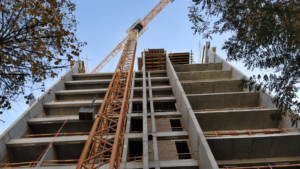Behind every successful construction project is a well-defined construction plan. And the more detailed this plan is, the more streamlined the project execution.
The plan has to cover all the aims and objectives of the project, the tasks that must be carried out, all the timelines, budgets, buffers, risks, communication channels, and many other factors.
Tackling all these is challenging, especially given the sheer complexity of construction projects.
However, a proper construction plan that contains five key elements, which we will explain today, will prepare you and your team for the project execution phase and make sure all phases are completed on time and within budget.
Read on to learn what an effective construction plan looks like.
In this article...
Project Scope
Every project plan begins with defining the final goal. But for effective construction planning, you also have to consider all the steps that have to be taken to get to that final point.
The document encompassing all these steps—all deliverables, activities, milestones, reports, deadlines and costs that will lead to the successful completion of a project—is called project scope.
This is the first key element of every effective project plan.
Clearly defining the project scope is essential to establish the objectives. But it is equally important to determine what is out of scope.
When you establish the boundaries of a project, you ensure that all stakeholders are on board and expect the same project outcome.
Moreover, you shield yourself from scope creep—the uncontrolled expansion or changes in a project’s scope that lead to delays and budget overruns.
When writing project scope, you should also consider potential limitations and risks. The more details you take into account at this stage, the easier it will be to handle bottlenecks later on.

So, how does one go about writing a comprehensive project scope?
To create a well-defined project scope, begin with a detailed project charter.
This essential document captures the project’s overarching goals, specific deliverables, existing constraints, and key assumptions.
For instance, if you’re undertaking the construction of a residential building, the initial step in defining the project scope is establishing the goal—to create a safe and functional living space.
The deliverables, or results of tasks in each phase, would then be:
- approved architectural and engineering plans
- a cleared construction site
- a completed foundation
- erected structural framework
- installed utilities
- finished interior spaces
- a certified, inspected building ready for occupancy.
The timeline would include sequential phases from permits and site preparation to final certification, ensuring a systematic progression.
For instance, you could define one month for the permitting phase, three weeks for site preparation, and so on.
Constraints might include budget limitations, regulatory restrictions, or specific zoning requirements, while assumptions could encompass stable weather conditions, timely availability of construction materials, and adherence to the approved plans.
As we said above, you also have to define what is outside the scope of your project.
If it was agreed that the construction project would encompass the renovation of the main building and the installation of new electrical systems, any additional requests for landscaping or exterior signage would be considered out-of-scope work.
When you gather all this information, including detailed requirements and expectations from stakeholders, you can write the project scope.
In essence, this document gives a clear understanding of what needs to be accomplished and the parameters within which the work will be conducted.
Once each stakeholder confirms and the project scope is formalized with a scope statement, you are given the green light for further project planning.
Work Breakdown Structure (WBS)
Construction projects, marked by their complexity and numerous tasks, demand effective task assignment and efficient resource allocation.
Work breakdown structure (WBS) is a way to facilitate task management through visual representation, making it another key element of a construction plan.
Let’s explore how.
Above, we explained that the project scope includes a list of deliverables.
The WBS takes this a step further, defining not just what needs to be achieved but also specifying what needs to be done and by whom to reach those deliverables.
This visual representation, often in diagram form, breaks work into smaller units, enhancing clarity for all project stakeholders and simplifying resource allocation.
As the saying goes, an image is worth a thousand words, and this is precisely how we could describe an efficient work breakdown structure.
Let’s take a look at the WBS of the residential building construction plan from our previous example.
Note: this is just a part of it—WBS can hold many more phases, deliverables and tasks based on project complexity.

To construct an effective WBS for a construction project like this one, begin by dividing the project into distinct phases.
In our case, the phases include planning, permitting, site preparation, foundation construction, and so on.
Subsequently, break down each phase into deliverables, specifying what needs to be achieved within those phases.
For instance, in the site preparation phase, deliverables involve clearing the site and marking boundaries for the foundation.
Then, break down each deliverable into work packages consisting of specific tasks and subtasks.
For the site preparation phase, these tasks include:
- Remove vegetation and debris from the construction site.
- Demolish any existing structures if necessary.
- Grade and level the construction site.
This hierarchical structure will give you the needed clarity to organize the workload. It will also help assign ownership at each level, from overall phases to specific tasks, fostering accountability.
In a nutshell, a work breakdown structure is an essential element of any construction plan.
It provides a structured framework that enhances clarity, simplifies resource allocation, and fosters accountability throughout the project lifecycle.
Communication Plan
The old saying that communication is the key holds even more true in complex construction projects, making a well-structured communication plan a necessity for a construction plan to be truly effective.
Good communication ensures that information flows seamlessly among team members and stakeholders, fostering a transparent, collaborative, and informed project environment.
If that’s not the case, you risk budget project delays, budget overruns, and general dissatisfaction among stakeholders.
In fact, a survey by Smart Tasking revealed that one-fourth of respondents cite communication breakdowns as a top reason for project delays.

However, with a robust communication plan in place, these challenges can become a thing of the past.
So, how do you develop an effective communication plan?
Here are actionable steps to ensure you are well-prepared to navigate communication throughout your project’s lifespan:
| Identify key stakeholders: | Pinpoint the individuals and groups interested in the project, including contractors, architects, regulatory bodies, and the client. To keep a detailed record, list their names, surnames, contact numbers, email addresses, and job titles. |
| Establish preferred communication channels: | Different stakeholders may prefer different communication methods. So, determine whether emails, in-person or online meetings, project management software, or a combination of these would be most effective for each group. |
| Define communication protocols: | Clearly outline how, when, and how often communication will occur. Establish regular update schedules to inform stakeholders about project progress and potential challenges. |
In addition to these three steps, it would be wise to specify a clear process for addressing issues or roadblocks.
Define who should be contacted, how to report issues, and the expected resolution time frame.
This will make sure that issues are reported on time and to the responsible people, which will lead to swift problem-solving and won’t impact your project timelines.
As you know, construction projects demand constant communication, and defining these aspects early on is critical to ensure project success.
With a comprehensive communication plan, you will lay the foundation for a smooth and well-coordinated project execution. But you should also make sure to adjust and improve the plan as the project progresses.
Risk Management Plan
Risks are inherent to construction projects.
They range from safety concerns on the job site to the risk of project costs exceeding estimates, delays in material deliveries, or unexpected weather events that can disrupt project timelines.
That’s why one of the most important things to do when planning a project is to identify all the possible risks that could happen during a project and prepare strategies to avoid or minimize those risks.
And, of course, add it to the construction plan.
How to go about a risk management plan? Let’s break it down.

Begin with a thorough risk analysis to identify all the potential risks that could disrupt the project.
Consider the risks from various categories:
- Financial risks
- Operational risks
- Legal risks
- Safety risks
- Environmental risks
- Other
Keep in mind that not all risks have the same impact. Also, it might happen that some of them won’t occur, but it’s always better to be safe than sorry.
So, categorize risks based on two key factors: severity and probability.
Severity gauges how bad a risk could be, while probability assesses how likely it is to happen.
For instance, contamination impacting public safety would be a severe risk but with a low probability if strict safety measures are in place.
With your risks laid out, it’s time to strategize.
Develop response plans for each identified risk.
For instance, if there’s a risk of a critical supplier facing production delays, what steps can be taken to minimize its impact?
A response strategy might involve identifying alternative suppliers, securing backup inventory, or negotiating flexible delivery schedules to mitigate potential disruptions to the construction timeline caused by supply chain challenges.
In addition to developing response plans for each identified risk, it’s crucial to incorporate contingency planning. This involves setting aside additional resources, time, or budget to manage unforeseen events.
Bottom line, a risk management plan is one of the most important elements of any construction plan.
When you anticipate what could go wrong, you are better prepared if it comes to that. And that safeguards your budget and timeline.
But it goes without saying that you should constantly monitor risks and adjust the risk management plan through the project’s lifecycle.
Visual Plan
The final step in comprehensive project planning is transforming the gathered information into visuals. Yes, you heard it right—visualize your plan.
A visual plan will convert your planning into an easily understandable and manageable format, significantly aiding in tracking project progress.
Moreover, a visual plan, like a Gantt chart, assists in identifying task dependencies within the intricate web of construction project tasks and timelines.
Dependencies can take various forms:
- Finishing one task to start the next. (FS)
- Finishing one task to conclude another. (FF)
- Starting one task to start another. (SS)
- Starting a task to complete the previous one. (SF)
The complexity of these dependencies can be overwhelming.
However, when you input all these tasks, due dates and dependencies into a Gantt chart, you will get a visual roadmap that clearly shows what should be done in which order.
The Gantt chart will also identify the longest chain of interdependencies, revealing the critical path—indicating how long it will take to complete the project from the beginning.

Creating such visual plans requires the assistance of project management tools.
Gantt charts, timelines, and various software are specifically designed to transform project details into a visual format that is both comprehensive and accessible.
These tools can also color-code phases to distinguish different stages of the construction schedule.
This simple yet effective technique will improve clarity for team members and make it easier for stakeholders to grasp the project’s progression.
For you or your project manager, these visual plans offer a clear overview of the construction project.
They enable you to add tasks, assign employees to the tasks, change task statuses, and keep an eye on the schedule, ensuring that the project progresses within defined timelines and budgets.
Overall, in construction projects where the sheer volume of tasks can be overwhelming, visual plans are highly necessary to stay on top of everything that needs to be accomplished throughout a project’s lifecycle.
Conclusion
And that brings us to the conclusion. Today, we explained the five key elements every effective construction plan needs.
The first is the project scope, defining the project’s goal and the various paths to achieve it. Next is the work breakdown structure, which decomposes the project scope into smaller, more manageable units, simplifying the overall workload.
Two additional critical elements are the communication plan and the risk management plan.
The former establishes clear communication channels and reporting schedules, fostering transparency, while the latter ensures preparedness to tackle potential risks that are bound to happen.
Finally, when you incorporate visuals into the construction plan, you make it easier to understand dependencies and track the progress of your project.
When you combine these five elements in an effective construction plan, you will be ready to take your construction project to the next level—project execution.








